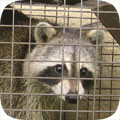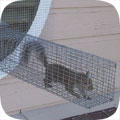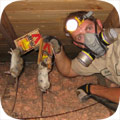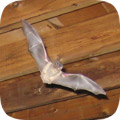- wheatonglenmont@wildlifeanimalcontrol.com
Call 24/7 for a free quote:
240-428-6370
Wheaton-Glenmont Wildlife Animal Control
Professional Wildlife Removal Company Servicing Wheaton-Glenmont, MD
If you have a problem with wildlife in your Wheaton-Glenmont home, your best option is to hire a company that specializes in Maryland wildlife removal only. This is a specialty business, and regular pest control companies do not use the proper techniques to solve animal problems. I have spent many years reviewing Maryland and Wheaton-Glenmont, and I recommend the following:
District Wildlife Solutions
Cell Phone: 240-428-6370
NOTE: If you have a dog or cat problem, call Montgomery County Animal Services: 240-773-5900

District Wildlife Solutions specializes primarily in removing animals from attics of homes and buildings - this includes squirrels in attics, raccoons, and rats or mice in homes. Maryland also has a documented problem with
bats in buildings, and District Wildlife Solutions is specially trained in bat removal. They also perform general wildlife trapping services, such as the capture and removal of skunks or opossums on the
property. Call 240-428-6370 to discuss your critter problem and schedule a same-day or next-day appointment. Click here to learn more about what prices we charge in 2020.
When hiring a company to solve your wild animal problem, you want these features:
- Specializes in wildlife removal, not pest control
- Fully Maryland and Montgomery County licensed and insured
- Works 7 days per week (critters don't take weekends off)
- Performs full building inspections: enters and inspects attic
- Performs exclusion repairs, with guarantee against animal re-entry
- Offers cleanup of biohazardous wildlife waste
District Wildlife Solutions is a full-service Wheaton-Glenmont wildlife removal company. This is very different from a regular Wheaton-Glenmont pest control company. The pest control companies spray poison to kill insects. This is not at all
similar to wildlife removal. District Wildlife Solutions performs a full inspection of the home or property, and determines why the animal(s) are there, and if inside a building, how the animals got inside. All
animals (including rodents) are trapped and removed, or if possible, removed from the building using special exclusion devices. Once the animals are gone, preventative repairs are essential, and
cleanup is sometimes recommended.
 Wheaton-Glenmont wildlife trapping - it's not as simple as it may seem. It's illegal in Maryland to trap without a license. Trap type is very important and there are many different types, bait is somewhat relevant, trap placement
is vital, and there are dozens of small things that are very important to know.
Safety is a concern. Then once the animal is trapped, it must be removed and dealt with in the proper manner according to Maryland law. We offer Wheaton-Glenmont raccoon removal. Read more about how to get rid of raccoons.
Wheaton-Glenmont wildlife trapping - it's not as simple as it may seem. It's illegal in Maryland to trap without a license. Trap type is very important and there are many different types, bait is somewhat relevant, trap placement
is vital, and there are dozens of small things that are very important to know.
Safety is a concern. Then once the animal is trapped, it must be removed and dealt with in the proper manner according to Maryland law. We offer Wheaton-Glenmont raccoon removal. Read more about how to get rid of raccoons.
 Animals in attics - this is our specialty at District Wildlife Solutions. Many types of animals like to live in attics. This includes squirrels, raccoons, rats, mice, bats, birds, and even possums. Critters like to go into attics for a safe place to live
and raise their young. Removing animals from attics is very complex work, partly because of the presence of baby animals. If you need Wheaton-Glenmont squirrel removal, we can remove all the squirrels from your attic, and seal out any future ones. Read more about how to get rid of squirrels.
Animals in attics - this is our specialty at District Wildlife Solutions. Many types of animals like to live in attics. This includes squirrels, raccoons, rats, mice, bats, birds, and even possums. Critters like to go into attics for a safe place to live
and raise their young. Removing animals from attics is very complex work, partly because of the presence of baby animals. If you need Wheaton-Glenmont squirrel removal, we can remove all the squirrels from your attic, and seal out any future ones. Read more about how to get rid of squirrels.
 Rodent control must be done in a very specific way. First off, the most important thing is that all the openings that rats and mice can use to enter a house be sealed. Then all the rodents must be physically trapped and removed.
Never, ever use poison! Most Wheaton-Glenmont exterminators will just use this lazy poison technique to kill rodents, and it causes more harm than good - dead stinky rats, and it doesn't solve the problem. Call us for correct Wheaton-Glenmont rat removal. Read more about how to get rid of rats.
Rodent control must be done in a very specific way. First off, the most important thing is that all the openings that rats and mice can use to enter a house be sealed. Then all the rodents must be physically trapped and removed.
Never, ever use poison! Most Wheaton-Glenmont exterminators will just use this lazy poison technique to kill rodents, and it causes more harm than good - dead stinky rats, and it doesn't solve the problem. Call us for correct Wheaton-Glenmont rat removal. Read more about how to get rid of rats.
 Bat removal is a highly specialized task. Maryland is known to have colonizing bats who often live in buildings. Bats love attics. If not removed, the colony can grow to a very large size over the years. The bat droppings are often corrosive and
cause health risks. The same goes for bird droppings on or in buildings. We perform Wheaton-Glenmont pigeon removal and bird control. But our specialty is Wheaton-Glenmont bat removal. We remove 100% of the bat colony and seal the building so that it's totally bat-proof. Read more about how to get rid of bats.
Bat removal is a highly specialized task. Maryland is known to have colonizing bats who often live in buildings. Bats love attics. If not removed, the colony can grow to a very large size over the years. The bat droppings are often corrosive and
cause health risks. The same goes for bird droppings on or in buildings. We perform Wheaton-Glenmont pigeon removal and bird control. But our specialty is Wheaton-Glenmont bat removal. We remove 100% of the bat colony and seal the building so that it's totally bat-proof. Read more about how to get rid of bats.
 If you have animals inside a house, no job is complete without proper exclusion repairs. If you simply hire a Wheaton-Glenmont trapper who only removes the critters, then the problem will return. You need to hire a Wheaton-Glenmont wildlife control company that identifies 100% of the animal entry points
into your building, and seals them shut with professional repairs. In addition, in many cases animals have left waste or contamination behind, and you'll want a company that can provide professional cleaning services. District Wildlife Solutions does both.
If you have animals inside a house, no job is complete without proper exclusion repairs. If you simply hire a Wheaton-Glenmont trapper who only removes the critters, then the problem will return. You need to hire a Wheaton-Glenmont wildlife control company that identifies 100% of the animal entry points
into your building, and seals them shut with professional repairs. In addition, in many cases animals have left waste or contamination behind, and you'll want a company that can provide professional cleaning services. District Wildlife Solutions does both.
The above are just some of the services offered by District Wildlife Solutions. We also trap and remove animals that destroy lawns, such as moles, or digging animals. Sometimes animals like opossums will live under buildings, steal pet food, raid garbage cans, etc.
Read about how to get rid of opossums. Skunks commonly live under sheds or decks, and set up a den. We can trap and remove them without them spraying. Read about how to get rid of skunks. District Wildlife Solutions
also provides dead animal removal in Wheaton-Glenmont. If you need help with any other wildlife conflict, from a fox, beaver, groundhog, or any other critter, we can solve it. We also do Wheaton-Glenmont snake removal - most of the snakes in Maryland are not venomous, but
call us if you want safe removal, or read about how to get rid of snakes in Wheaton-Glenmont. And remember, we are a private business, not Montgomery County Animal Control Services, so if you have a dog or cat problem, call the County at 240-773-5900.
Montgomery County animal services does not handle any wildlife issues.
District Wildlife Solutions: 240-428-6370
Wheaton-Glenmont Pricing Info For Year 2020
 Every wildlife removal situation is different, from the species of animals involved, the location of the animal inside a house or outside, the extent of repairs or cleanup, etc. It's impossible to give one-size-fits-all prices. Examples MIGHT include:
Every wildlife removal situation is different, from the species of animals involved, the location of the animal inside a house or outside, the extent of repairs or cleanup, etc. It's impossible to give one-size-fits-all prices. Examples MIGHT include:
Small Job: For example, a one-stop job to remove an animal in the yard: $100 on up
Medium Job: For example, getting critters out of your house with minor repairs: $300 on up
Large Job: For example, a project involving many service trips and complex work: $500 on up
Give us a phone call now and tell us about your wildlife issue and we will be able to give you a price estimate over the phone. If you're cool with it, we can schedule a same-day or next-day appointment if you like. Our prices are fair, and a good value because we do the job right, the first time.
Wheaton-Glenmont Wildlife Tip #1:
How To Trap A Coyote
The coyote is very much like a collie dog and is a member of a larger family which dogs and wolves are a part of known as the canidae family. It is native to North America. Direct conflicts between coyotes and humans are very rare since they have a tendency to keep away from humans, and are mostly do not pose any danger to humans. However, indirect conflicts on the other hand happen very often. These include;
1. Coyotes attacking and feeding on livestock and pets.
2. Coyotes having rabies or other dangerous diseases being in the vicinity.
3. Concern about wellbeing of children in areas where coyotes dwell.
Humans are therefore necessitated to exploit methods to curb these occurrences and this is where trapping of the coyotes comes in as one of the many methods preferred by the humans.
Trapping is also preferred by humans who want the coyotes' fur for trade reasons which are actually legal in most places but only to licensed hunters. Trapping is not legal in all places, so if you are reading this, then you should first check with the local authorities before you go on to trapping, so that you can be on the safe side.
Trapping of coyotes is not as easy as it sounds. It is best done by the experts since it really needs some experience and skill. You will need a few tools before you get down to the real thing, which will also depend on the technique you desire to use. These include;
1. A live cage trap.
2. A coil spring trap.
3. A snare trap.
4. Thick scent free gloves, etc.
1. Best spot for a trap.
To setup the fastest most effective trap, one would need to place it in a spot where the coyotes frequent the most. One should first look for indicators like coyote tracks, upset grass or vegetation, animal remains or upset dirt and then place a few traps there.
2. Deciding the most befitting method.
Trapping methods vary due different factors, the main one being the purpose of the trapping. They include:
A. Live cage trap- this is best applicable where the animal is needed alive. It is not the most successful in most cases but is very much preferred by fur traders since minimal damage if at all is done to the fur in the process.
B. The coil spring trap- this method is the most commonly used, especially by the experts. The trap grabs the coyote's paw and doesn't let go. When using this trap one should have a rough idea of the size and weight of the coyote they want to trap and therefore use an appropriately weighted and firm trap, lest the coyote goes free. Novices are not advised to use this method since handling the trapped coyote after is best when handled by an expert.
C. A snare trap- this trap gives the coyote a quick painless death by chocking it with the cord in the trap whose loop gets tighter as the coyote tries to loosen the grip and go free.
3. Trap placement.
Now, after deciding which trap to use and where, then we will need to actually set the trap. Here it is key that the trap is laid in a hole, covered up in some dirt or dry vegetation, and is as inconspicuous as possible to keep it well hidden from the coyotes. This setup is most appropriate for both the snare and coil spring traps. Live bait is highly recommended since coyotes are more attracted to live prey.
4. Scent.
Coyotes naturally keep away from humans at just about all costs and this is mostly fueled by their strong noses. So, if there is any human scent on a trap, then coyotes are less likely to come close and thus the trap might prove useless. To avoid this, one should use thick, apple-cider scented or absolutely scent free, gloves when placing a trap. Finally, with all this done carefully and to the letter, then trapping your coyote should not take you long.
Wheaton-Glenmont Wildlife Tip #2:
Maryland Wildlife Information:
Maryland State bird: Baltimore oriole
State mammal: Thoroughbred, calico cat, Chesapeake Bay retriever
State reptile: Diamondback terrapin
State fish: Striped bass
State insect: Baltimore checkerspot butterfly
Maryland is one of the most diverse states in the country, and it is so unique in its variety of habitats, it has been dubbed "America in miniature". This nickname is due to the fact the state has sand dunes, sea grass, swamps with tall cypress trees, thick oak forests on rolling hills, and mountains covered in pine woods. Despite the multiple ecosystems that exist in Maryland, there are no natural lakes in the state. Glacial activity did not extend into Maryland, and no deep holes were present to hold massive volumes of water. There are numerous natural ponds, but mankind has been forced to make the now plentiful lakes in the state.
Maryland is one of only a few states that have a population of wild horses. No horses in the United States are native; every herd is descended from stock brought over by explorers or settlers when the continent was first discovered. The horses in Maryland are contained on coastal islands. The horses are protected by law, and are allowed to roam free because of their historical relevance.
Horses aren't the only large grazers that aren't native to Maryland. Sika deer were originally introduced to the state, and are now populous enough to warrant a hunting season. The largest native grazer is the American elk, followed by the white-tailed deer.
Maryland doesn't just have large grazers, it also has large predators. Black bear are the most common large predators in the state, followed by coyotes in frequency of sightings. Wolves and mountain lions are much more reclusive but also share territory in the state.
Maryland wouldn't be complete without a list of common animals. Anywhere in the region you can find skunks, raccoons, porcupines, foxes, opossums, voles, moles, woodchucks, fishers, nutria, ermine, and mink. There are also bats, snakes, and a host of amphibians.
Being a coastal state, Maryland has an abundance of marine life, many of which are showcased in the Baltimore Aquarium. The list of marine wildlife includes sperm whales, beaked whales, dolphins, porpoises, humpback whales, and manatees. Of course, with a beach environment comes a large population of seagulls. Seagulls are one of the most problematic nuisance birds for business and homeowners along the coast. Their droppings are highly corrosive and can pose health risks for people.
You can always call District Wildlife Solutions, any time of day, at 240-428-6370, for a price quote for Wheaton-Glenmont wildlife control services. I am confident that this is the best choice amongst wildlife removal companies in Wheaton-Glenmont, MD.





































